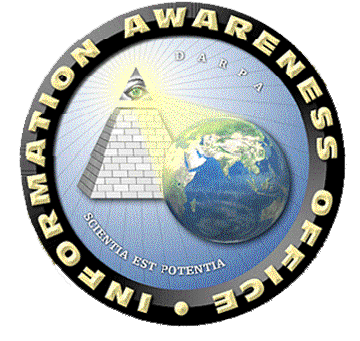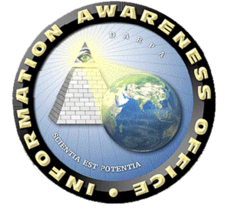|
|
|

Information Awareness Office (IAO) |
|
|
Information Awareness Office
seal
The Information Awareness Office (IAO) was established
by the Defense
Advanced Research Projects Agency (DARPA), the research and development
agency of the United
States Department of Defense, in January 2002 to bring together several
DARPA projects focused on applying information technology to counter transnational
threats to national
security. The IAO mission was to "imagine, develop, apply, integrate,
demonstrate and transition information
technologies, components and prototype, closed-loop, information systems
that will counter asymmetric
threats by achieving total
information awareness". Following public criticism that the development
and deployment of these technologies could potentially lead to a mass
surveillance system, the IAO was defunded by Congress
in 2003, although several of the projects run under IAO have continued
under different funding.
IntroductionThe IAO was established after Admiral John
Poindexter, former United
States National Security Advisor to President Ronald
Reagan and SAIC
executive Brian Hicks approached the US
Department of Defence with the idea for an information awareness program
after the terrorist attacks of 9/11.[1].
Poindexter and Hicks had previously worked together on intelligence-technology programs for the Defense Advanced Research Projects Agency. DARPA agreed to host the program and appointed Poindexter to run it in 2002 The IAO began funding research and development of the Total Information Awareness (TIA) Program in February 2003 but renamed the program the Terrorism Information Awareness Program in May that year after an adverse media reaction to the program's implications for public surveillance. Although TIA was only one of several IAO projects, many critics and news reports conflated TIA with other related research projects of the IAO, with the result that TIA came in popular usage to stand for an entire subset of IAO programs. The TIA program itself was the "systems-level" program of the IAO that intended to integrate information technologies into a prototype system to provide tools to better detect, classify, and identify potential foreign terrorists with the goal to increase the probability that authorized agencies of the United States could preempt adverse actions. As a systems-level program of programs, TIA's goal was the creation of a "counterterrorism information architecture" that integrated technologies from other IAO programs (and elsewhere, as appropriate). The TIA program was researching, developing, and integrating technologies to virtually aggregate data, to follow subject-oriented link analysis, to develop descriptive and predictive models through data mining or human hypothesis, and to apply such models to additional datasets to identify terrorists and terrorist groups. Among the other IAO programs that were intended to provide TIA with component data aggregation and automated analysis technologies were the Genisys, Genisys Privacy Protection, Evidence Extraction and Link Discovery, and Scalable Social Network Analysis programs. The first mention of the IAO in the mainstream media came from New York Times reporter John Markoff on February 13, 2002.[2] Initial reports contained few details about the program. In the following months, as more information emerged about the scope of the TIA project, civil libertarians became concerned over what they saw as the potential for the development of an Orwellianmass surveillance system. On August 2 2002, Dr. Poindexter gave a speech at DARPAtech 2002 entitled "Overview of the Information Awareness Office"[3] in which he described the TIA program. On November 14, 2002 the New York Times published a column by William Safire in which he claimed "[TIA] has been given a $200 million budget to create computer dossiers on 300 million Americans."[4] Safire has been "credited" with triggering the anti-TIA movement.[5] In addition to the program itself, the involvement of Poindexter as director of the IAO also raised concerns among some, since he had been earlier convicted of lying to Congress and altering and destroying documents pertaining to the Iran-Contra Affair, although those convictions were later overturned on the technicality that the testimony used against him was protected. On January 16, 2003, Senator Russ Feingold introduced legislation to suspend the activity of the IAO and the Total Information Awareness program pending a Congressional review of privacy issues involved.[6] A similar measure introduced by Senator Ron Wyden would have prohibited the IAO from operating within the United States unless specifically authorized to do so by Congress, and would have shut the IAO down entirely 60 days after passage unless either the Pentagon prepared a report to Congress assessing the impact of IAO activities on individual privacy and civil liberties or the President certified the program's research as vital to national security interests. In February of 2003, Congress passed legislation suspending activities of the IAO pending a Congressional report of the office's activities (Consolidated Appropriations Resolution, 2003, No.108–7, Division M, §111(b) [signed Feb. 20, 2003]). In response to this legislation, DARPA provided Congress on May 20, 2003 with a report on its activities.[7] In this report, IAO changed the name of the program to the Terrorism Information Awareness Program and emphasized that the program was not designed to compile dossiers on US citizens, but rather to research and develop the tools that would allow authorized agencies to gather information on terrorist networks. Despite the name change and these assurances, the critics continued to see the system as prone to potential misuse or abuse. As a result House and Senate negotiators moved to prohibit further funding for the TIA program by adding provisions to the Department of Defense Appropriations Act, 2004[8] (signed into law by President Bush on October 1, 2003). Further, the Joint Explanatory Statement included in the conference committee report specifically directed that the IAO as program manager for TIA be terminated immediately.[9] Components of TIA projects that continue to be developedDespite the withdrawal of funding for the TIA and the
closing of the IAO, the core of the project survived.[10]
Legislators included a classified annex to the Defense Appropriations Act
that preserved funding for TIA's component technologies, if they were transferred
to other government agencies. TIA projects continued to be funded under
classified annexes to Defense and Intelligence appropriation bills. However,
the act also stipulated that the technologies only be used for military
or foreign intelligence purposes against foreigners.[11]
TIA's two core projects are now operated by Advanced Research and Development Activity (ARDA) located among the 60-odd buildings of "Crypto City" at NSA headquarters in Fort Meade, MD. ARDA itself has been shifted from the NSA to the Disruptive Technology Office (run by to the Director of National Intelligence). They are funded by National Foreign Intelligence Program for foreign counterterrorism intelligence purposes. One technology, now codenamed "Baseball" is the Information Awareness Prototype System, the core architecture to integrated all the TIA's information extraction, analysis, and dissemination tools. Work on this project is conducted by SAIC through its Hicks & Associates, consulting arm that is run by former Defense and military officials and which had originally been awarded US$19 million IAO contract to build the prototype system in late 2002.[12] The other project has been re-designated "TopSail" (formerly Genoa II) and would provide IT tools to help anticipate and preempt terrorist attacks. SAIC has also been contracted to work on Topsail, including a US$3.7 million contract in 2005. IAO researchIAO research was conducted along five major investigative
paths: secure collaboration problem solving; structured discovery; link
and group understanding; context aware visualization; and decision making
with corporate memory.
Among the IAO projects that TIA was intended to integrate were:
The IAO seal The IAO uses the eye
of Providence from the Great
Seal of the United States gazing at the Earth
as logo, and the Latin
motto scientia est potentia, meaning "knowledge is power". The pyramid
has 13 steps, the same of that on the US
1 dollar bill.
As criticism of TIA grew in late 2002, the pyramid logo was removed from the official IAO webpage and replaced with a new logo. In response to questions about its removal, the IAO responded in February 2003 with a "Statement regarding the meaning and use of the IAO logo" published as a FAQ.[24] The original descriptions of the IAO, TIA, and the biographies of senior staffers were also removed from the DARPA web site although they remain widely available on the Internet.[25] Public criticism of the Information Awareness OfficeExtensive criticism of the IAO in the traditional media
and on the Internet has come from both the left and the right—from civil
libertarians and libertarians—who believe that massive information aggregation
and analysis technologies lead to a form of dataveillance
that can threaten individual liberties. To some, these developments are
seen as another step down the slippery
slope to a totalitarian
state. Others believe that development of these technologies is inevitable
and that designing systems and policies to control their use is a more
effective strategy than simple opposition that has resulted in research
and development projects migrating into classified programs.
On November 27, 2002, San Francisco Weekly columnist Matt Smith decided to illustrate the perils of information proliferation to the IAO director, Adm. John Poindexter, by disclosing Poindexter's private home address and phone number, as well as those of Poindexter's next-door neighbors. This information quickly propagated through the Internet, and some protesters created web sites republishing this and other personal data.[26] References
See also
External linksMedia coverage
Academic articles
Critical views (established sources)
Critical views (less well recognized)Proponent views
|
|
| FAIR USE NOTICE: This page contains copyrighted material the use of which has not been specifically authorized by the copyright owner. Pegasus Research Consortium distributes this material without profit to those who have expressed a prior interest in receiving the included information for research and educational purposes. We believe this constitutes a fair use of any such copyrighted material as provided for in 17 U.S.C § 107. If you wish to use copyrighted material from this site for purposes of your own that go beyond fair use, you must obtain permission from the copyright owner. | |
|
|

Webpages © 2001-2016 Blue Knight Productions |